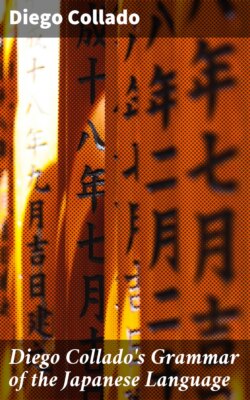Читать книгу Diego Collado's Grammar of the Japanese Language - Diego Collado - Страница 8
На сайте Литреса книга снята с продажи.
THE CONJUGATIONAL SYSTEM
ОглавлениеTable of Contents
| Affirmative | Negative | |
| INDICATIVE MOOD | ||
| Present | aguru | aguenu |
| Perfect | agueta | aguenanda |
| Pluperfect | aguete atta | aguenande atta |
| Future | agueôzu | aguru mai |
| Future perfect | aguete arǒzu | —— |
| IMPERATIVE MOOD | ||
| Present | ague io | aguru na |
| Future | agueôzu | aguru mai |
| OPTATIVE MOOD | ||
| Present | avare ague io caxi | avare aguru na caxi |
| Preterit | agueôzu mono vo | aguru mai mono vo |
| Future | avare ague io caxi | avare aguru na caxi |
| SUBJUNCTIVE MOOD | ||
| Present | agureba | agueneba |
| Perfect | agueta reba | aguenanda reba |
| Pluperfect | aguete atta reba | —— |
| Future | agueô toqi | aguru mai qereba |
| PERMISSIVE SUBJUNCTIVE MOOD | ||
| Present | agueredomo | aguenedomo |
| Preterit | agueta redomo | aguenanda redomo |
| Future | agueôzu redomo | aguru mai qeredomo |
| INFINITIVE | ||
| Present | aguru coto | aguenu coto |
| Preterit | agueta coto | aguenanda coto |
| Future | agueô coto | aguru mai coto |
| GERUND IN DI | ||
| Present | aguru [jibun] | aguenu [jibun] |
| Future | agueô [jibun] | aguru mai [jibun] |
| GERUND IN DO | ||
| —— | aguete | agueĩde |
| GERUND IN DUM | ||
| Present | aguru tame | aguenu tame |
| Future | agueô tame | aguru mai tame |
| SUPINE IN TUM | ||
| —— | ague ni | —— |
| SUPINE IN TU | ||
| —— | ague | —— |
| PARTICIPLE | ||
| Present | aguru fito | aguenu fito |
| Preterit | agueta fito | aguenando fito |
| Future | agueô fito | aguru mai fito |
| The forms treated separately are: THE CONDITIONAL | ||
| Present | agueba | aguezũba |
| Preterit | agueta raba | aguenanda raba |
| Future | agueô naraba | aguru mai naraba |
| THE POTENTIAL | ||
| Present | aguru ró | aguenu coto mo arózu |
| Preterit | aguetçu ró | aguenanzzu ró |
| Future | agueôzu ró | aguru mai coto mo arózu |
The Structure of Collado's and Rodriguez' Descriptions Contrasted
In every section of his description, Collado is indebted to the material presented by Rodriguez in his Arte da Lingoa de Iapam. The structure of the Ars Grammaticae, however, follows a much more simplistic design than that of the Arte. As a consequence Collado found it necessary to assemble his data from various sections of Rodriguez' description. In the paragraphs which follow we will briefly sketch the structural relation between these two grammars.
As he clearly states in his title to the main portion of the grammar Collado bases his description on the Introductiones of Antonio Lebriya, and more specifically upon that portion of the great Latin grammar which dealt with the parts of speech. Further, he limits himself to the spoken language rather than attempting, as does Rodriguez, an integrated treatment of both the spoken and written grammars.
Under these influences Collado's grammar takes on the following form:
